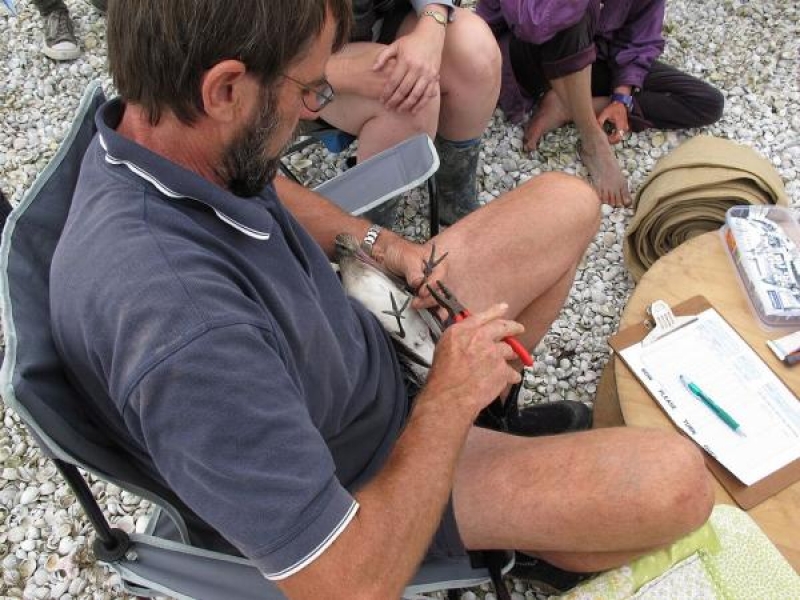E7 - A Far-Flying Godwit
Posted by Sue Farley on 28 September 2016
Tags: farewell spit bar-tailed godwits E7 Godwit Loss of habitat godwits migratory birds new zealand

A big part of what makes Farewell Spit so special is its attraction to migratory birds. And some of the most well-known of these birds are the bar-tailed godwits or kuaka - Limosa lapponica baueri - which make the huge flight to and from Alaska each year.
The idea of perpetual summer sounds appealing, but it comes at a price. The godwits fly almost non-stop to get to their northern summer feeding grounds in Alaska and then fly, without a stop, back to New Zealand. It's a remarkable journey, and until 10 years ago it was one that could really only be guessed at. Scientists knew the birds could fly a phenomenal distance, but had no way of verifying this.
Fortunately, with improvements in tracking technology and the ability to make the transmitters much smaller, the guesswork was removed. In a joint venture between the US Geological Survey and other groups including scientists at Massey University, 16 godwits were fitted with tiny transmitters in February 2007, before their expected departure in March. These birds were spread between Miranda/Piako and Farewell Spit.
True to form most of the birds left New Zealand in March, heading north. After flying for seven days and nights they arrived in Yalu Jiang, on the border of China and South Korea, where they stop to feed and rest. That's a non-stop flight of 10,200 kms, which had scientists very excited. After a five week stopover the birds carried on to their northern summer grounds in Alaska, another 5,000 km flight
Although the transmitters were only expected to deliver data for the 'uphill' trip they did, in fact, keep broadcasting for the return trip as well, giving exact data for the flights of a number of birds. The first tracked bird to return to New Zealand was the now famous E7.
According to the data, E7 left Miranda/Piako, near Auckland, on 17th March 2007 and flew 10,200 kms to Yalu Jiang in the standard seven days. Yalu Jiang is a traditional stopping point for these birds as it has a large wetland area for them to feed on and recharge. After 38 days there, on 1st May E7 took off for Alaska, flying around a large area of bad weather, and landing briefly at Nelson Lagoon in Alaska, before carrying on to the Yukon-Kuskokwim Delta in south-west Alaska. She had flown a further 6,460 kms and arrived at her final destination on 17th May.
During the summer E7 rested, fed and probably bred, then fattened up again for the flight south.
She left the breeding grounds on 18th July and, after a further 41 days feeding on the Kuskokwim Delta, E7 launched back into the air and flew all the way back to Miranda/Piako in just eight days. Unlike seabirds, waders' feathers are not entirely waterproof so they cannot stop mid-flight and rest on the water. They continue flying, resting on the move by shutting down one side of their brain at a time, and navigating by analysing polarised light and following the stars and the sun.
E7's track took her toward Hawai'i but before reaching there she turned slightly right and headed directly to New Zealand. She arrived back at Miranda/Piako on 7th September 2007 competing the longest recorded non-stop flight of any bird. She flew 11,570 kms non-stop from Alaska to New Zealand in eight days, completing a total round trip of 29,181 kms.
This story isn't without a tinge of sadness though. Although E7 and her tracked buddies completed the round trip, as they do every year, the number of bar-tailed godwits world-wide has dropped hugely in recent times. From an estimated 155,000 bar-tailed godwits in the 1990s there are possibly now only 90,000 left, and around 10,000 of them spend the summer on Farewell Spit each year. The reason for this change is unclear, but with vast tracts of wetlands along the eastern coasts of China and Korea being drained, the godwits are losing the habitats where they refuel on their Asian stopover. Maybe this is affecting how many birds actually complete the round trip, or even survive the year?
The good news though, was that of the godwits fitted with transmitters at Farewell Spit back in that 2007 summer, one bird (Z4) made it back to the spit the following spring, with at least 11,000 kms flying time behind her. Another, Y3, took the opportunity for a quiet winter and stayed to feed at the spit right through winter. No overseas travel for her that year.
pic credit - thanks to Wilma Verburg (Own work) [CC BY-SA 3.0 nl (http://creativecommons.org/licenses/by-sa/3.0/nl/deed.en)], via Wikimedia Commons
